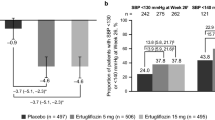Summary
Establishing the overall efficacy or safety of a drug requires a unified methodological approach and analysis of all clinical trials to be included. As an example, this paper presents the aggregated dose-response relationship of efficacy data and a last-value analysis of laboratory data across all studies of the antihypertensive drug project carvedilol. Hemodynamic endpoints were calculated as change from the baseline blood pressure and pulse after an average treatment of 2–4 weeks whereas metabolic endpoints were calculated as changes from the baseline until the last day with respect to glucose, potassium, creatinine, lipids and liver function (median duration of treatment was 8–12 weeks). All antihypertensive trials were reanalyzed using an intent-to-treat principle. Aggregated efficacy data (mean, standard deviation, sample size) for each allocated group within each study were combined by means of meta-analysis separately for o.d. or b.i.d. dose regimens. Laboratory data were aggregated similarly within each study, using the last active drug as a grouping factor. The results showed that the patient population was treated adequately with 25 mg carvedilol o.d. The dose response curve for o.d. regimens shows a typical sigmoid shape: a steeper increase from 12.5 mg to 25 mg carvedilol, which then flattens (25 mg, 50 mg, 100 mg carvedilol o.d.). No superiority of a b.i.d. dose regimen over a o.d. dose regimen by means of BP lowering could be detected. There was a considerable variation in the results between studies, much bigger than the dose-response effect, most due to monocentric trials. No tendencies were observed for any of the laboratory parameters after a median exposure time of 8 to 12 weeks up until the last day of active drug treatment.
Similar content being viewed by others
References
Meyer-Sabellek W, Agrawal B (1992) Antihypertensive profile of carvedilol. Clin Investig 70:S43-S52
Kaski JC, Rodriguez-Plaza L, Brown I, Maski A (1987) Efficacy of carvedilol in exercise-induced myocardial ischemia. J Cardiovasc Pharmacol (Suppl 11) 10:137–140
DasGupta P, Lahiri A (1992) Can intravenous beta blockade predict long-term hemodynamic benefit in chronic congestive heart failure secondary to ischemic heart disease? Clin Investig 70:S98-S104
Cochran WG (1954) The combination of estimates from different experiments. Biometrics 10:101–129
Hedges L (1985) Statistical issues in the meta-analysis of environmental studies. Proceedings of the biopharmaceutical section; American Statistical Association
US Department of Health and Human Services, FDA (1988) Guideline for the format and content of the clinical and statistical sections of an application
Bundesministerium für Jugend, Familie, Frauen und Gesundheit (1989) Allgemeine Verwaltungsvorschrift zur Anwendung der Arzneimittelprüfrichtlinien, Bundesanzeiger 29.12.1989
Boissel JP (1989) Considerations for the meta-analysis of randomized clinical trials. Controlled Clin Trials 10:254–281
Author information
Authors and Affiliations
Rights and permissions
About this article
Cite this article
Stienen, U., Meyer-Sabellek, W. Hemodynamic and metabolic effects of carvedilol: a meta-analysis approach. Clin Investig 70 (Suppl 2), S65–S72 (1992). https://doi.org/10.1007/BF00207614
Issue Date:
DOI: https://doi.org/10.1007/BF00207614




